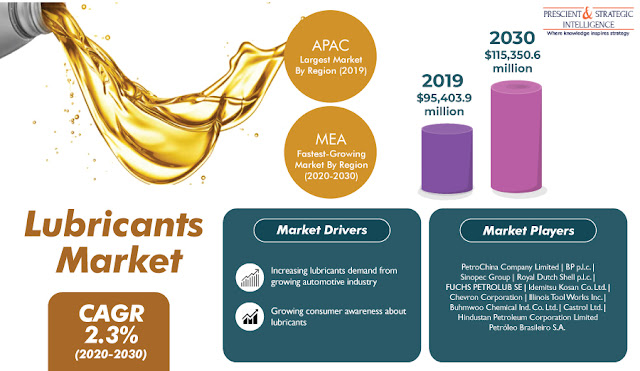
Why Does Automobile Industry Require Lubricants?
The International Organization of Motor Vehicle Manufacturers (OICA) stated that, in 2020, 53,598,846 passenger cars and 24,372,388 commercial vehicles were sold across the world. The soaring adoption of automobiles can be majorly ascribed to the mounting per capita income of people in countries such as Brazil, India, Mexico, and China. Lubricants are utilized in the crankcase of the automotive engine to ensure the efficient operation of automobiles. The usage of these crude oil by-products also helps in increasing the lifespan of vehicles, as these products reduce the vehicle’s wear and tear.
Thus, the increasing adoption of automobiles in developing nations and burgeoning consumer awareness about the benefits of these crude oil by-products will help the lubricants market advance at a CAGR of 2.3% during 2020–2030. According to P&S Intelligence, the market is expected to generate a revenue of $115,350.6 million by 2030. Lubricant producers across the world are adopting customer-oriented methods to generate brand awareness through visual and print media. Additionally, the provision of gifts and free samples by such production companies during promotional campaigns and trade shows also helps in imparting awareness regarding lubricants.
Geographically, Asia-Pacific (APAC) led the lubricants market in the recent past and it is expected to retain its dominance in the coming years as well. This is due to the rapid shift of manufacturing facilities to Asian nations from Western countries, owing to the availability of cost-effective labor and the existence of flexible environmental rules in the region. Moreover, the surging automobile production and sales will also augment the use of lubricants in the region. For instance, according to the Society of Indian Automobile Manufacturers (SIAM), India produced 22,652,108 vehicles and sold 18,615,588 automobiles during the financial year 2020–2021.
Whereas, the Middle East and African (MEA) region is expected to consume lubricants at the highest rate in the coming years, due to the existence of numerous oil wells in the region. Additionally, the flourishing manufacturing sector, owing to the mounting focus of MEA nations on diversifying their economies and reducing their economic reliance on oil, will also boost the adoption of lubricants in the region in the foreseeable future. Manufacturing facilities in MEA countries obtain lubricants at a low cost, due to the abundant availability of oil reserves in the region.
Thus, the burgeoning vehicle sales and growing consumer awareness about the benefits of lubricants will fuel the consumption of lubricants in the forthcoming years.
Comments